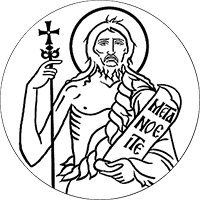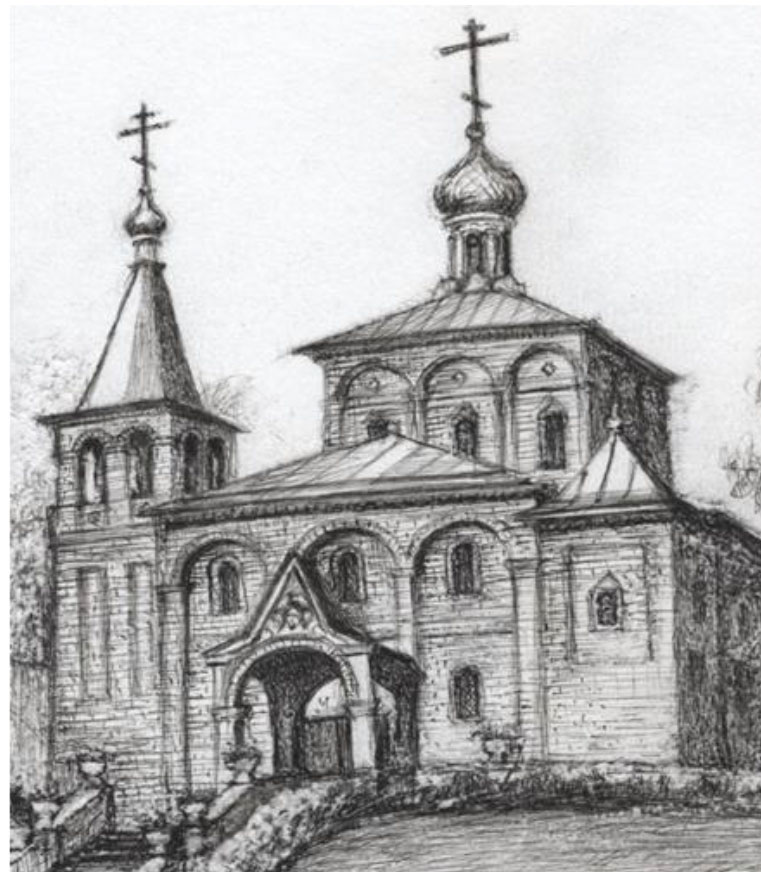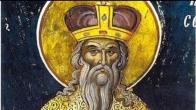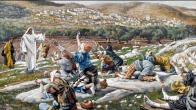You are here
On Pious Behavior in Church
From time to time, new parishioners ask us to explain how one should behave during church services. First of all, one must come to the realization that everything externally taking place in church is an expression of our internal feelings, and must be consonant with them. Thus, for example, a prostration is a sign of humility. Accordingly, as we bow, we should humble our hearts. Otherwise, our prostrations are but an empty formality. The sign of the Cross is an expression of our faith in the crucified Lord. Accordingly, when the movement of our hand making the sign of the Cross should unite with our feelings and thoughts directed to the Cross of Christ Whose sign we place upon ourselves. Otherwise, it is what is some characterized as "waving of the hand" or, as what used to be called in olden times "polishing buttons." The words of our prayer should never be merely words. Rather they should always be filled with meaning. Our heart should speak in and through them. Otherwise, prayer is an empty gesture, bereft of any content.
In our spiritual lives, what is external, i.e. everything known as ritual, is secondary. The Gospels teach us to prefer the spiritual over the physical. "The sabbath was made for man, and not man for the sabbath." (Mark 2: 27). Christ says to the scribes and Pharisees: "Ye hypocrites, well did Esaias prophesy of you saying: This people draweth nigh unto Me with their mouth, and honoureth mMe with their lips; but their heart is far from me." (Matthew 15: 7-8). "Woe unto you, scribes and Pharisees, hypocrites!. For ye make clean the outside of the cup and of the platter, but within they are full of extortion and excess. Thou blind Pharisee, cleans first that which is within the cup and platter, that the outside of them may be clean also…" (Matthew 23: 25-26). We see in the Gospels, we see that nothing so raised the Lord to indignation as did hypocrisy and overt displays of legalism. Religious piety in which a man's heart does not participate is but an empty worship of ritual and formalism.
* * *
We should come to public services on time, and make an effort not to leave until their completion, unless there are extremely compelling circumstances requiring us to leave early. Even in secular society, this is an elementary rule of good upbringing and a sign of respect for the others who have assembled.
According to long-standing practice, women enter the church with heads covered. For women to be in church wearing slacks or wearing dresses with hemlines above the knee is impermissible. When going to church, we should remember the words of the Gosepl: "Therefore, if thou bring thy gift to the altar, and there rememberest that thy brother hath ought against thee; Leave there thy gift before the altar, and go thy way; first be reconciled to thy brother, and then come and offer thy gift." (Matthew. 5: 23-24).
Pious Russian custom called for not eating before the Divine Liturgy. That such a custom was actually observed in Russia is demonstrated by the following: When antidoron or prosphora would be brought to someone who, for whatever reason, had not been at the Liturgy, he would not consume it if he had already eaten breakfast. Rather, he would leave it "for the next morning," so that he might consume it on an empty stomach. From this one would conclude that if all those present at the conclusion of the Liturgy eat the prosphora given to them, they are doing so on an empty stomach.
An Orthodox Christian should not miss either Sunday or Festal church services. The Sixth Ecumenical Council says the following in this regard: "In case any Bishop, or Presbyter, or Deacon, or anyone else on the list of the Clergy, or any layman, without any graver necessity or any particular difficulty compelling him to absent himself from his own church for a very long time, fails to attend church on Sundays for three consecutive weeks, while living in the city, if he be a Cleric, let him be deposed from office; but if he be a layman, let him be removed from Communion." (Canon LXXX of the Sixth Ecumenical Council).
Upon entering the church, we should make the sign of the cross, accompanied by a bow to the waist, three times. After bowing toward the Altar, and venerating the Festal Icon and the other Icons, we should bow to our brothers and sisters also present in the church. If we so desire, we may light candles before the Icons, and if a Liturgy is taking place, we may offer prosphora for commemoration.
We should avoid walking around the church unless absolutely necessary, especially at the most important points in the Liturgy, e.g. during the Small Entrance (i.e. when the Holy Gospels are brought out of the Altar); during the reading of the Word of God, during the Cherubic Hymn; of course, during the Eucharistic Canon (beginning with the clergyman's statement "Let us stand well, let us stand with fear [of God]…" and ending with the singing of "Meet it is…" and the prayerful commemoration "Among the first remember…"); during the Lord's Prayer; and during Holy Communion.
It is best to offer prosphora for the health and for the repose before the public part of the Liturgy begins, i.e. while the Proskomedia is still in progress. They should not be offered immediately before the singing of the Cherubic Hymn, for that is the point in the Liturgy at which the Great Entrance is about to take place. By offering prosphora at that time, we force the priest to interrupr the Service so that he can read the lists of names offered and complete the Proskomedia commemorations; thisinevitably results in a delay.
In the iconostasis, the Icon of Christ stands to the right of the Royal Doors, while the Icon of the Mother of God stands to the left. Analogously, men should stand in church on the right side, while women should stand on the left. Everyone is supposed to stand during Divine Services in the Orthodox Church. Of course, that requirement does not apply to the sick, the aged, or to children, who may sit without harboring any doubts or false feeling of shame.
The church, where the bloodless Sacrifice is offered, where the Powers of Heaven invisibly serve alongside us, is no place for idle conversation. That understanding would seem to be so elemental, that no comment should be required. On reverencing an Icon of the Savior, we should kiss Christ's feet. On reverencing Icons of the Mother of God or the Saints of God, we should kiss the hands. On reverencing the Icon of the Savior Not-Made-By-Hands, or of the Head of St. John the Baptist, we should kiss the hair.
Before discussing the matter of prostrations, I would like to underscore once again the fact that one's external [gestures] have a meaning of secondary importance, or perhaps it would be better to say, have a derived meaning. The external is of no value unless it is corresponds to an internal meaning. Thus, the internal is greater than the external. For example, before making the sign of the Cross, one must direct one's heart and mind toward the Crucified Lord. Before making a prostration, one must feel one's submission and obedience to God. Before kissing an Icon or placing a candle before it, one must have love and reverence for the one depicted on the Icon. It is only under those conditions that the Church permits the use of external rituals and symbols.
The physical movements of the body associated with prayer are useful, for they permit the entire body to participate in prayer and to be blessed by it. Physical movements help us to focus our thoughts, as it were to give life to the gesture, to render it not abstract, but real. Small prostrations, or bows to the waist, are done in church during petitions (ektenias), after each individual petition. By the way, one should not "break/interrupt the Cross," i.e. one should not bow until after completing the act of making the sign of the Cross. We should perform a small prostration in response to our being censed, and in response to the priest's blessing. By the way, in these cases, as the priest makes the sign of the Cross with his hand or with the censer, we should bow toward him without making the sign of the Cross. Those who are seated should stand up during censing and during the priestly blessing. We bow to the waist at the Small Entrance during the Liturgy and during Vespers, and each time the Gospel, an Icon or the Cross is brought out of the Altar.
We make prostrations when venerating the Cross, an Icon, the Gospel, or Holy Relics. The following order is to be observed: Make two small prostrations, kiss the Holy Object, and then make an additional small prostration. At the Great Entrance during the Liturgy we stand with bowed heads, for the Great Entrance symbolizes the Lord's Entry into Jerusalem in anticipation of His passion. It is an important part of the Liturgy. We also stand with heads bowed during the reading of the Holy Gospel. Such a posture helps us concentrate, and helps us avoid looking about during such an important part of the Service. We bow our heads each time the priest says "Bow your heads (or 'let us bow our heads') unto the Lord," for during these times the priest reads a so-called "private" prayer on behalf of all. We should make the sign of the Cross with all due care and attention. It is better not to make the sign of the Cross at all than to make it carelessly.
Our prayer in church is communal prayer, in which both clergy and laity participate. All of us, the clergy and the laity, comprise the visible, earthly Church. In the church building, we see before us icons of those who are invisibly present: the Mother of God, Queen of Heaven and the earth, along with those others whom the Church has glorified. And the Head of the Church, our High Priest, the Lord Jesus Christ, himself sits on the Throne in the Altar, in the form of His Body and Blood.
With what reverence and trembling ought we to stand before such a most sublime assembly! The Church of God is the House of God, and in it a particularly prayerful atmosphere ought to reign. Not only do the clergy and the singers bear responsibility for this, but so does each individual person praying. Loud conversations in church, very much disturb those who are trying to delve into the words of the divine service and those who are attempting to "collect their soul" for confession. It is not only loud conversations that disturb the peace of the church. Not infrequently one cannot help but notice that even during the most important points in the Divine Services, some people (especially young people) are standing in church with their hands in their pockets, or are crossing - in front of the reader or the priest - from one side of the church to the other, or are sitting on a bench with their legs crossed. This is absolutely impermissible. Parents will sometimes give an entire prosphora even to quite small children, who then drop crumbs all over the floor; people walk on these crumbs and thereby involuntarily trample the sanctified bread. Would it not be better for parents themselves to give their children prosphora a piece at a time, and see to it that they do not drop crumbs? Sometimes children come to church with chewing gum in their mouths. We ask parents to instill in their children the understanding that this is completely impermissible.
To preserve decorum in the church, we remind everyone of a few of the rules of outward prayerful behavior:
- One should come to church in time for the beginning of the divine service.
- On entering the church, one should sign oneself thrice with the sign of the cross.
- One should not linger at the entrance to the church, since this makes it difficult for other people to enter. Those desiring to pay membership dues or to conduct any other monetary transactions (other than buying candles) should do so either before or after, but under no circumstances during, divine services; such action disturbs the order and decorum of God's House.
- Ancient church custom establishes that men are to stand on the right side and women on the left.
- No conversations are permitted in the Temple of God, either during the divine service or after its conclusion.
- In church, handshakes are superfluous unnecessary, and kissing of women's hands is completely impermissible.
- The faithful are to come to church in attire appropriate to their gender. Some attire that may be permissible to wear on the street or at the beach is completely unacceptable in church, and one may under no circumstances come to divine services so attired: Immodest clothing violates the decorum of the church's setting. It is impermissible for women to be at services dressed in short dresses (i.e. hemline above the knee), in trousers or in apparel with shoulders and arms uncovered. We remind our young people and their parents, that one may not come to church in a T-shirt (especially with blatant slogans or with depictions of idols of pop culture etc.), or in sneakers. Boys over seven years of age may not come to church in shorts.
- Those who have come to the divine service late should move forward quietly, without pushing those who are praying.
One should not move about, buy or place candles, or venerate icons during the following most important points in the divine services:
At the All-Night Vigil:
- During the entrance of the priest or deacon with the censor at Vespers.
- During the reading of the Six Psalms. During the reading it is forbidden to place candles (when all the lights in the church are turned off).
- When the priest comes out with the Holy Gospel and during the reading of the Gospel at Matins.
- During the singing of "More honorable than the Cherubim" and the Great Doxology ("Glory to God in the highest").
At the Liturgy:
- During the Little [with the Gospel] and the Great [with the Chalice] Entrances.
- During the reading of the "Prayer for the Salvation of Russia".
- During the reading of the Epistles and the Gospels.
- During the singing of the Cherubic Hymn [from the words: "Let us who mystically represent the Cherubim" until the final three-fold singing of "Alleluia."]
- During the Eucharistic Canon [from the exclamation: "The doors! The doors! In wisdom, let us attend!"; throughout the singing of the Symbol of Faith: "I believe in one God…"; throughout the whole Canon, when "A mercy of peace" is sung, until the conclusion of the hymn to the Theotokos: "It is truly meet…", or if it is a feast, until the conclusion of the hymn (zadostoinik) sung in its stead]. This is the part of the Liturgy at which to show greatest reverence; throughout this whole time there is to be no walking about the church or extinguishing of candles.
- During the singing of "Our Father".
On prostrations, and what kind are to be done during the Liturgy.
According to the rules of the Holy Orthodox Church, full prostrations (head to the ground) - symbolizing extreme humility before God - are not done on Sundays, for on those days we celebrate a little Pascha. On the day of His Glorious Resurrection from the dead, Christ the Savior reconciled us to God.
Full prostrations are, however, called for during Liturgies served on weekdays. The first full prostration in the Liturgy is done after the Creed, as the priest says "Let us give thanks unto the Lord!" and the choir responds by singing "It is meet and right to worship the Father, Son, and Holy Spirit…" At that point the priest reads a prayer in which he thanks the Lord for bringing us from non-being into being, for once again restoring those who had fallen away from Him. He thanks the Lord for all of His blessings, both those we know of and those unknown to us, and for the peaceful sacrifice ("a mercy of peace"), that we are about to offer. Thanks to this prayer of thanksgiving, the entire impending church service is known as the "Eucharist," from the Greek word meaning "thanksgiving." All of the faithful perform the first full prostration at this point as a sign of their thanks to God for their entire lives.
Everyone makes a second full prostration at the singing of "To Thee we sing…," i.e.. during the Mystery of the changing of the Holy Gifts, at the priest's words "changing them by Thy Holy Spirit. Amen. Amen. Amen!"
Christ Himself is present in the Holy Gifts. Everyone makes a third full prostration to the Mother of God at the words "Especially for our Most holy, Most pure, Most-blessed, Most-blessed Lady Theotokos and Ever virgin Mary." At this time, the Choir sings "It is truly meet to bless thee, the Theotokos…" We revere the Mother of God as "more honorable than the Cherubim and beyond compare more glorious than the Seraphim." By her was the Incarnation of God accomplished. She gave birth to God our Savior.
The ustav calls for a fourth full prostration at the singing of the "Our Father," the Lord's Prayer, for us is of absolutely unique importance. It is the greatest of prayers, for it was given to us by the Lord Himself (see Matthew 6: 9-13). As we pronounce the words "give us this day our daily bread," let us think not only of ordinary bread, but about the eucharistic Bread of which many soon are to partake. Let us pray that the Lord might give us "this day" His divine Bread, unto the healing of soul and body.
We make the fifth full prostration when the Holy Gifts are brought out for Communion of the laity, as the priest or deacon says "With fear of God, with faith and love draw nigh!" According to the Orthodox Faith, in the Mystery of the Eucharist bread and wine changes into the Body and Blood of Christ. We bow down before the Holy Gifts as before Christ Himself, for He is mystically present in them.
The sixth full prostration is done at the end of the Liturgy, after the singing of "We have seen the True Light…" At this point, the priest secretly prays: "Be Thou exalted above the heavens, O God, and Thy glory above all the earth!" In the Liturgy, this final appearance of the Holy Gifts to the people, and their subsequent transfer deep into the Altar, to the Table of Prothesis, depicts the Ascension of Jesus Christ into Heaven. The Gospel states that while Christ was ascending, the Apostles bowed down before Him (Luke 24: 52); likewise, at the final appearance of the Holy Gifts we make a full prostration. Those who have communed do not make this last prostration, for they not only observe and contemplate on Christ as the other faithful do, but they also have Him within themselves!
Archpriest Victor Potapov, 2002
PARISH LIFE
RECENT VIDEOS
Address of our Cathedral
Subscribe to our mailing list
While all the materials on this site are copyrighted, you may use them freely as long as you treat them
with respect and provide attribution on the Russian Orthodox Cathedral of St.John the Baptist of Washington DC.









